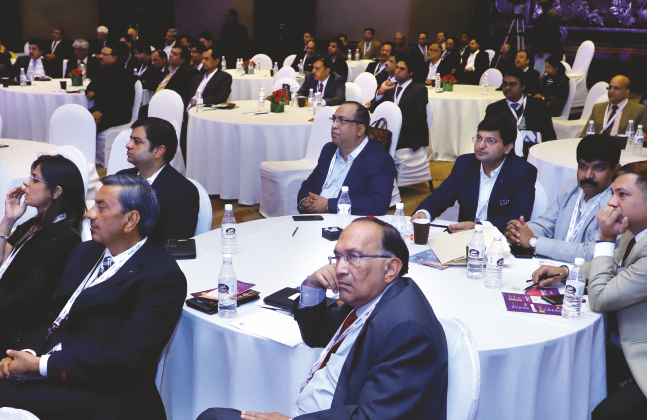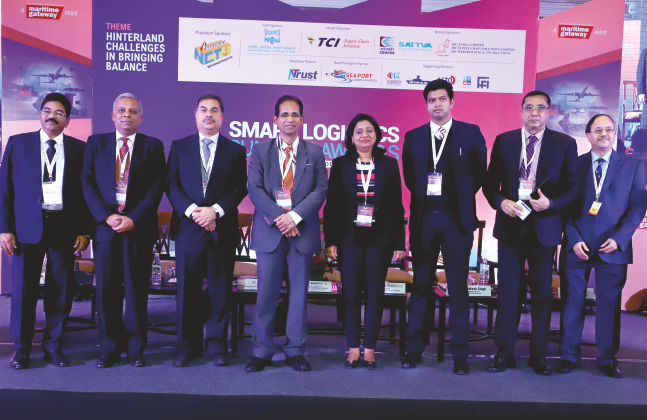The first business session witnessed robust discussions among the panelists which crystallized some of the contentious issues regarding hinterland movement and exports.
Ramprasad, Editor-in-Chief and Publisher, Maritime Gateway, in his introductory statement began the key session by defining the parameters along which the discussions could be followed. He said the total exim volume from the north central region was 1.4 to 1.5 million teus. The growth in trade constituted 40 per cent exports and 60 per cent imports, which has led to imbalance in the hinterland. Though the northern region was the jewel in the crown, there were problems. There were challenges of cargo flows to the nearby ports.
The dominance of cargo movement by road over rail continued unabated. Mundra received 50 per cent of the cargo from the Northern region, Pipavav received 10 per cent and JNPT the balance 40 per cent. Food processing was a major contributor to exports from the northern region, then comes auto and auto ancillaries. Other commodities were mineral, metals and textiles.
The ball was set rolling by Jasjit Sethi, CEO, Transport corporation of India – Supply chain solutions. He listed three developments in the NCR region that would bring in change in the logistic sector.
The first was the completion of the ring road around Delhi, called the Kundli, Manesar, Palwal and the Eastern Peripheral Expressway, spanning a length of 270 kms. This stretch was opened for traffic on 19th November. Earlier the ICD in the NCR region had their own catchment area. It was not viable to do trucking to these ICDs from other locations. Though the impact on development of the new Expressway was yet to be felt, Sethi felt that this development would change the complexion of the functioning of the ICDs in the NCR region.
The second significant development has been the raising of axle weight for trucks by the government of India by 12 to 14 per cent. This particular development would further propel the shift to road. The bulk of the movement to the ports was by road.
The third aspect had been the warehousing space around the NCR. When GST was introduced the biggest area to be impacted was the NCR because of the proximity of other states. The warehousing space in the NCR had come down. People had consolidated warehouses. The NCR would now be feeding the states around it. He felt that the warehousing space around the NCR region to be about 60 million sq ft.
More terminals were not required in the NCR region, was the opinion of Sanjay Swarup, Director (International Marketing and Operations), Concor. There were already 13 ICD terminals in the NCR.
Swarup said that the west coast terminals were well served by the NCR in comparison to the east coast ports primarily because the distance was much less. Further there was no regular two way traffic between the NCR and the east coast ports. However the east coast ports like Krishnapatnam and Kolkata, Vizag, had shown increase in volumes.
Swarup also announced that in cases where the CTO’s had to provide 180 teus to earn a rebate of 3 to 4 per cent, they realised that it was difficult task for them to fulfil the condition. Instead they were working on a slot arrangement which was to be announced soon.
Tarun Kalra, Vice President North MSC Agency (India) Private Limited asked whether the sheen on the jewel in the crown was wearing off. He felt that the container traffic from this region was on the wane.
He also felt that there was fragmentation in the industry which could be avoided. Forums such as these should be used to “defragment”. Some sort of collaboration was needed to be established to avoid internal conflicts which tended to bring all the participants down.
On the question of erosion of freight movement to road, Swarup said that they were able to stem the flow wherever there was double stack container movement. The commissioning of the DFC, would further stem the hemorrhage.
S K Rahman, IRS, Additional Director General, Directorate General of Goods & Services Tax (DG-GST) spoke on how GST was affecting the shipping industry.
The E way bills have been introduced and the check posts have been removed. The major beneficiaries were the transporters who would now be using larger vehicles for carriage of goods. He stressed that the exports were growing and at the same time the refunds were being processed.
Goods can be exported on payment of IGST and refunds could be sought thereafter. If one was not willing to pay IGST, the same could be transacted under bond and accumulated credit could be obtained. The Returns process had been simplified. From 1st April a new process for Return would be introduced.
In the shipping sector major amendments have been introduced. The place of supply was earlier shown as the place from where the goods were being exported. Now the place of supply for the goods being exported is the destination outside India which gives the benefit of not paying IGST.
The E Way bills have been further streamlined. In the case of imported goods to CFS or ICD, E Way bill need not be filed. E Way Bill was also not required for all goods under Customs Bond and handling of empty containers. If the operation was inside the port, the individual state governments, could waive off the requirement of E Way Bill. SOPs have been issued for imposition of penalty of `500 for minor errors instead of the earlier procedure of detaining vehicle and the goods.
In cases of transport of goods from one place to another, if the goods were not accepted at the destination, they could be stored at the transporters warehouse which would be registered as the additional place of business for the shipment.
They have appointed nodal officers at various places. Exclusive nodal officers have been appointed for problems encountered in E Way Bills. He urged the stakeholders to come forward for resolution of any issues.
Rahman gave an important clarification in the case of cross trade movement from a second country to a third country. In the service tax regimes these shipments were exempted, but now 18 per cent GST was being charged. He clarified that the goods moving outside the country did not come under the purview of GST, even if the billing was made to an entity in India.

Vinita Venkatesh, Director, Navayuga Container Terminal Pvt Ltd, spoke on the relevance of the east coast port for the northern region. She stated that the combined capacity of east coast ports, was 5.9 million teus, whereas the cargo was only 3 million teus. The east coast was a buyers market. Further there was zero congestion and the ease of business had considerably improved. It did not make sense that imports from China should go right round the peninsular India to the west coast ports and then move to Hyderabad in south.
CONCOR was willing to start a rail service between Hyderabad and Krishnapatnam. Vinita said there would be at least $200 saving per box. CONCOR would benefit too because their trains would have a shorter circuit and better utilisation of equipment.
Despite these obvious advantages why the shipping lines and Custom House Agents still use Nhava Sheva as their port, questioned Vinita?
Likewise in Nagpur too, all the cotton yarns go to the west coast ports and then from there to south-east Asian destinations. There would be considerable
time savings if the goods were to go from the east coast ports, she stated. They were working to start a direct service Krishnapatnam to Chittagong which was expected to be announced in February. There would be substantial reduction in costs and time.
She urged the solar panel importers in the north to use the east coast ports for their imports because they were fully cognizant of their needs and could cater to all their requirements. They had formed a company called Ocean to Door particularly to provide all assistance to them.
Finally with the implementation of cabotage waiver, they had a good feeder service to the ports in the east coast. Currently two major shipping lines Maersk and Hyundai were bringing in cargo into Krishnapatnam for transhipment instead of Singapore or Port Klang. They enjoyed twin advantages of lower feeder and transhipment cost. Today Krishnapatnam was the largest transhipment port on the east coast she claimed.
Collaborations, competitions and sharing of assets among the stakeholders inevitably come under the radar of the regulators, like the Competition Commission of India (CCI). Rudresh Singh Managing Associate Luthra & Luthra Advocates gave some insights on this vital issue.
Singh noted that there has been quite a few collaborations in the shipping and logistics sector. There had been regulatory notices on terminals and shipping line for which the CCI has taken up investigations and were awaiting final orders. There had been a host of issues among the various stakeholders in the shipping industry. However he clarified that most of these issues have come under scrutiny were merely to examine if there were primarily legacy issues.







